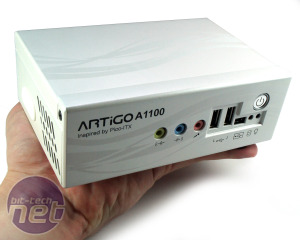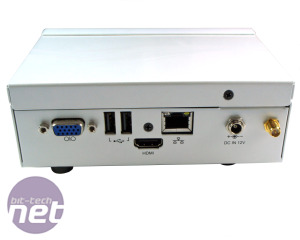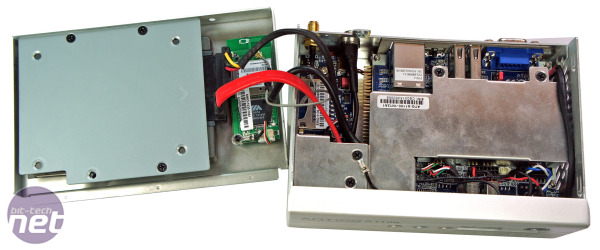VIA Artigo A1100 Pico-ITX kit review
Manufacturer: VIAUK Price (as Reviewed): £199 (inc VAT)
US Price (as Reviewed): $238 (ex tax)
VIA loves making small form factor standards. It first introduced the mini-ITX size with its EPIA brand, and since then its gone even smaller with Pico-ITX. However, where mini-ITX growth has recently exploded because the boards can still fit standard micro-ATX and ATX cases, finding wider support for Pico-ITX is difficult because of its non-standard layout. Still, as a company that has access to the entire PC platform, VIA has gone it alone with its own barebones kit: the Artigo A1100.
At just 146 x 99 x 52mm in size, and with a capacity of around 725 cubic centimetres, it's difficult to appreciate just how small the Artigo is until you realise the whole thing fits in one hand. You can even buy a VESA mount and hang it on the back of compatible monitors. Alternatively, if you have a spare VESA mount arm, you can have it hanging in the air as part of some surreal steampunk/robotic mod (if you make it - we definitely want to see it)!
All the Artigo kit needs is a 2.5in hard disk and a single DDR2 SODIMM memory module (of only up to 2GB) to get going - the rest is already packed inside. It doesn't come with WiFi as standard, but a small PCB add-on can be bought separately and simply screwed into the spare spot.
Inside, the Artigo is packing a single-core U2500 VIA Nano mobile CPU which is clocked at 1.2GHz and which idles at just 100mW with a maximum TDP of just 6.8W. The only difference between the U2500 and the more recent U3300 introduced a year after appears to be the introduction of SSE4.1; hardly a demanded feature, so we're not missing out.
The CPU is paired with a 2.3W VX855 single-chip MSP (Media System Processor, a combined GPU, Northbridge and Southbridge) on an 800MHz (effective) Front Side Bus. It's hardly a powerhouse partnership, but the CPU has out-of-order execution, unlike Intel's Atom, as well as 64-bit OS support. Fundamentally however, the kit is designed for basic computing activities in the smallest space possible.
The DirectX 9 graphics in the VX855 chipset will make even Intel's integrated graphics appear fast, as it doesn't have enough grunt for Aero in Windows 7. However, it does include WMV9, MPEG2/4 and H.264 acceleration 'up to 1080p', but its driver support limits playback to using Windows Media Player. That's fine for using Windows Media Center then, but those who prefer Media Player Classic or VLC could struggle. It's a certainly something worth noting, as the CPU alone doesn't have much power to process video alone.
There are more OSes out there than Windows though, which we all know is, er... 'big boned'. Linux drivers are available on VIA's website for Fedora, SuSe, Ubuntu and Xandros. A lightweight Linux distro such as Xubuntu shouldn't tax the hardware too much while giving you plenty of features and application support, for example.

MSI MPG Velox 100R Chassis Review
October 14 2021 | 15:04












Want to comment? Please log in.